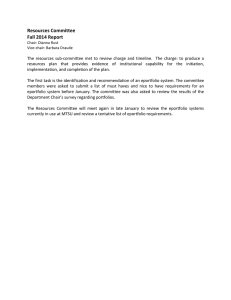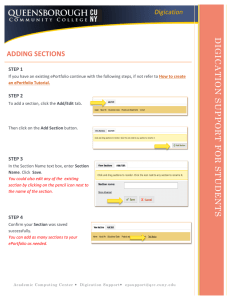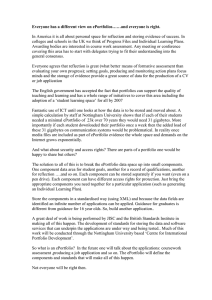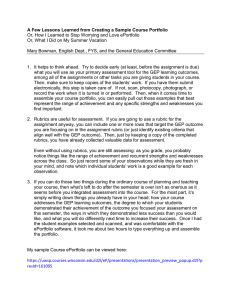RIPPLL HE Scenario 1: the use of an ePortfolio to support transitions between education and the workplace
advertisement
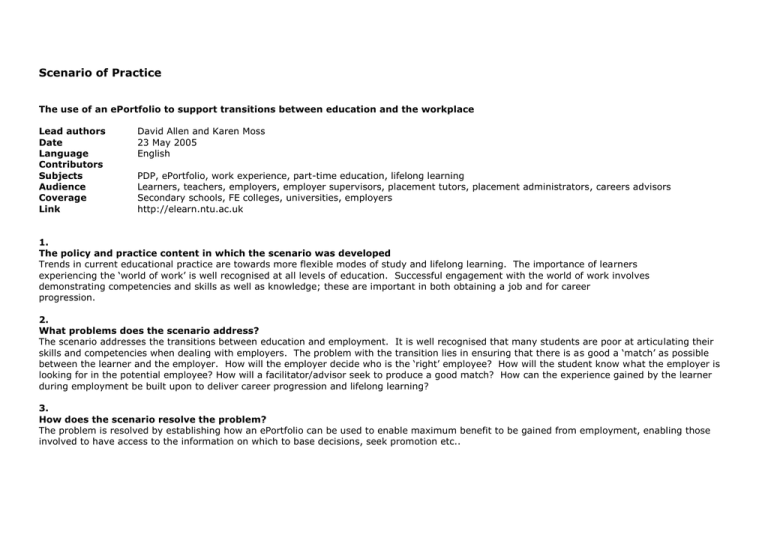
Scenario of Practice The use of an ePortfolio to support transitions between education and the workplace Lead authors Date Language Contributors Subjects Audience Coverage Link David Allen and Karen Moss 23 May 2005 English PDP, ePortfolio, work experience, part-time education, lifelong learning Learners, teachers, employers, employer supervisors, placement tutors, placement administrators, careers advisors Secondary schools, FE colleges, universities, employers http://elearn.ntu.ac.uk 1. The policy and practice content in which the scenario was developed Trends in current educational practice are towards more flexible modes of study and lifelong learning. The importance of learners experiencing the ‘world of work’ is well recognised at all levels of education. Successful engagement with the world of work involves demonstrating competencies and skills as well as knowledge; these are important in both obtaining a job and for career progression. 2. What problems does the scenario address? The scenario addresses the transitions between education and employment. It is well recognised that many students are poor at articulating their skills and competencies when dealing with employers. The problem with the transition lies in ensuring that there is as good a ‘match’ as possible between the learner and the employer. How will the employer decide who is the ‘right’ employee? How will the student know what the employer is looking for in the potential employee? How will a facilitator/advisor seek to produce a good match? How can the experience gained by the learner during employment be built upon to deliver career progression and lifelong learning? 3. How does the scenario resolve the problem? The problem is resolved by establishing how an ePortfolio can be used to enable maximum benefit to be gained from employment, enabling those involved to have access to the information on which to base decisions, seek promotion etc.. 4. The Scenario This scenario involves the transitions of learners between education and the workplace. It essentially concerns transitions of students from colleges of FE and universities into employment either on a full-time, part-time, sandwich placement or work experience basis. Students at colleges of FE may choose to seek direct entry to a university (see A in flow diagram) or these students may also seek full-time employment (B). A third alternative is that they may seek employment but then continue their studies at a college of FE on a part-time basis (C). Students on university programmes may chose to apply for a full-time position within a company at the end of their studies (D). Alternatively they may gain employment then study further by a part-time route at university (E). Some students at university will be on sandwich degrees requiring them to spend 30+ weeks on a work placement and others will undertake relatively short periods of work experience outside the university (F). At all these transitions the ePortfolio can provide useful data to enable the student to be matched with the requirements of the situation into which they are going and to enable maximum benefit to be obtained. 5. Flow Chart FE College University A = FE College to university full-time A B = FE College to full-time employment C = FE College to employment and continue in part-time study (FE) B D C Employers E F D = University to full-time employment E = University to employment and continue in part-time study (HE) F = University student on sandwich placement/work experience 6. The same narrative told from the perspective of different actors Learner’s Perspective The information in the ePortfolio and a meeting with a careers advisor help me match myself with the requirements of the University to which I am applying. I forward extracts from my ePortfolio. I am offered a place conditional on obtaining certain grades in my final examinations. Employer’s Perspective A I have been advised that the best route for me is to go into employment from FE. I use my ePortfolio to create a short presentation/extract of information to apply for a job, selecting aspects that fit the job profile. B I have applied for a job where a condition of employment is that I undergo further study at a college of FE. I then want to transfer my ePortfolio records to both the employer and the college. A conflict that may occur is that this is something I have been asked to do not something I would have chosen to do myself. C The services in the ePortfolio and a meeting with the Careers Advisor helped me to identify suitable careers and possible employers. I draw from my ePortfolio to D A (HR Manager) I have a job description and person specification. I need to ensure that the person I employ fulfils the criteria I have set. I receive information from the applicant’s ePortfolio and make a decision. A conflict that may occur is in choosing the best or any applicant. What action do I then take? (HR Manager) I want to maximise my company’s investment in the employee in the long term and hence want them to build and reflect upon their course of study using the ePortfolio. B C (FE Coll. Admissions Officer) I want to use ePortfolio data to ensure that the student is suited to the course. (Registry Clerk) I want to be able to transfer information to employers’ records and facilitate outcomes from the course being transferred into the ePortfolio and the final transcript of results. (Department Manager) I want skilled staff to carry out the job effectively. A conflict is that I am losing their time whilst at college. (HR Manager) From the information in online application form I can highlight particular competencies I am seeking in employees and identify strong candidates Uni/FE College Perspective (Admissions Officer) I want to use ePortfolio data to ensure that the student is suited to the course applied for. I must make sure that the processes are transparent and fair so that all decisions on whom to admit to the university can be justified (potential conflict between applicant and the university). D (Uni. careers advisor) I advise applicant on areas of the ePortfolio to use in application. I help applicant to match self with employer criteria. create tailored presentations or fill out application forms for individual employers. I use my ePortfolio to provide examples to show that I match the job profile. I am offered employment and explore ways of maintaining my portfolio with the employer (CPD). for interview. (Registry Clerk) I produce a transcript of the student’s final results profile for attachment to the portfolio. (HR Manager) I use the ePortfolio to identify particular strengths and areas for development of new employee. I need to address how ongoing CPD will be added to the portfolio. I have applied for a job where a condition of employment is that I undergo part-time study at university. I then want to transfer my ePortfolio records to both the employer and the university. A conflict is that this is something I may not have chosen to do myself although I do expect my career prospects to benefit through taking this part-time study. E In Year 2 of my course I looked for a suitable company who would take me for a 30 week placement. I worked with placement staff at university to find suitable companies to apply to. I provided the placement company with selected information from my ePortfolio. Whilst on placement I use my portfolio to keep a log of my development as an aid to writing my industrial training report and to help in the presentation I will give on return to university. F (HR Manager) I want to maximise my company’s investment in the employee in the long term and hence want them to build and reflect upon their course of study using the ePortfolio. E (Registry Clerk) I want to be able to transfer information to employers’ records and facilitate outcomes from the course being transferred into the ePortfolio and the final transcript of results. (Department Manager) I want skilled staff to carry out the job effectively. A conflict is that I am losing their time whilst at university. (HR Manager) I use the ePortfolio to identify particular strengths and areas for development of new employee. I need to address how ongoing CPD will be added to the portfolio. (Placement Supervisor) I will access portions of the ePortfolio as allowed by the student to look at their profile, strengths/ weaknesses etc. to decide on initial role and job targets. We agree training programme with the student, the outcomes of which can be entered ion the ePortfolio. (Academic staff member) I need to produce an online reference for the learner tailored to a particular job for which they are applying. (Uni. Admissions Officer) I want to use ePortfolio data to ensure that the student is suited to the course. F (Placement staff) I attempt to match the student to the requirements of the employer based on the student’s electronic CV and my knowledge of the company/job description. (Academic Placement Tutor) I brief thestudent on all aspects of the placement, including how to use the ePortfolio whilst on placement e.g. reflective journal, skills development etc. I arrange end of placement assessment. (Visiting Tutor) I have access to the student record online and electronic CV. I visit the student and check that they are fulfilling their obligation to the employer and having a satisfactory placement. I ensure that they are maintaining their portfolio. (Registry Clerk) I want to facilitate outcomes from the course being transferred into the ePortfolio and the final transcript of results. 7. Main types of stakeholder Learners Employers Universities FE Colleges Want Want Want Want a good employment experience and develop knowledge, skills and competencies to get the right person in the job and maximise their potential to ensure a good experience in work and produce good employment statistics to produce employable students and deliver qualifications 8. Sub types of stakeholder Sub types of Learner FE to full-time study FE to FT employment FE to employment with PT study HE to FT employment Employment to HE PT study HE to SW/work Wants Wants to move information from one environment to another to optimise employability/career management “ “ “ “ “ experience Sub types of employer FT employees Sandwich placements PT employees Sub types of University staff Admissions staff Placement staff Careers advisor Visiting Tutor Registry staff Wants to get the right person for the job. Wants good information on which to base decisions on whom to employ. Wants to ensure proper development of the individual and to ensure that the person adds value to the company. “ “ Wants to find right course for student and optimise numbers. Wants to find good student/employer match, enhance student employability, promote reputation of university. Wants to prepare student for placement/employment, and enhance employability of student (First Destination Survey). Wants to ensure continuity of placements, relationship with companies (sponsorship/3 rd stream income), maximise career opportunities, welfare of student. Wants to produce accurate and complete student record, transcripts and PDP. 9. List of other actors Placement Supervisor (employer) HR Manager (including recruitment) HR Administrator Portfolio Manager/Administrator A person within a company who takes responsibility for mentoring the student on work experience, directing their work and providing support A person who has the responsibility for making decisions on whom the company will employ and dealing with various aspects of employment A person who has the responsibility for dealing with records and various types of correspondence in relation to an employee A person who has responsibility for aspects of ePortfolio management systems
